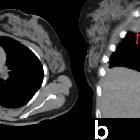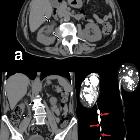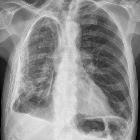extrapulmonary tuberculosis





























































Extrapulmonary tuberculosis (TB) refers to the haematogenous spread of Mycobacterium tuberculosis.
Pathology
Extrapulmonary tuberculosis can occur as a primary form of the disease, i.e. direct infection of an extrapulmonary organ without the presence of primary pulmonary tuberculosis or it can occur as a result of the spread of primary pulmonary tuberculosis.
It appears classically as tuberculous granulomata (tuberculomas) within the affected organs. However, certain forms of the disease exist manifesting with specific findings:
- CNS
- tuberculous meningitis
- tuberculous pachymeningitis
- intracranial tuberculous granuloma (tuberculoma)
- focal tuberculous cerebritis
- intracranial tuberculous abscess
- tuberculous rhombencephalitis
- tuberculous encephalopathy
- head and neck
- musculoskeletal
- abdominal tuberculosis
- gastrointestinal tuberculosis
- esophageal tuberculosis
- gastric tuberculosis
- duodenal tuberculosis
- jejunal and ileal tuberculosis
- ileocecal tuberculosis
- colorectal tuberculosis
- tuberculous peritonitis
- tubercular lymphadenopathy
- visceral tuberculosis
- hepatic tuberculosis
- gallbladder tuberculosis
- pancreatic tuberculosis
- splenic tuberculosis
- genitourinary tuberculosis
- renal tuberculosis
- bladder and ureteric tuberculosis
- prostatic tuberculosis
- scrotal tuberculosis (testes, epididymis, seminal vesicles, vas deferens)
- tuberculous pelvic inflammatory disease (female)
- gastrointestinal tuberculosis
Radiographic features
Widely variable dependent on the site of involvement. It is best to refer to site-specific articles.
As tuberculous organ infection can mimic malignant disease recent studies have reported the usefulness of FDG PET-CT in evaluating and following up patients in whom the diagnosis is in doubt .
Siehe auch:
- Tuberkulose
- pulmonale Tuberkulose
- Pleuraplaques
- Tuberkulose des ZNS
- Kavernöse Lungenläsionen
- Miliartuberkulose
- Nierentuberkulose
- miliare Lungenherde
- pleurale Tuberkulose
- primary pulmonary tuberculosis
- Tuberkulose des Peritoneums
- tuberkulöse Spondylitis
- tuberkulöse Halslymphknoten
- skelettale Tuberkulose
- urogenitale Tuberkulose
- post primary pulmonary tuberculosis
- muskuloskelettale Tuberkulose
- Pleuritis exsudativa
- tuberkulöse Meningitis
- Tuberkulose der Mamma
- mutifocal skeletal tuberculosis
- pelvine Tuberkulose
- tuberkulöse Otomastoiditis
- post-primary pulmonary tuberculosis

 Assoziationen und Differentialdiagnosen zu extrapulmonale Manifestationen der Tuberkulose:
Assoziationen und Differentialdiagnosen zu extrapulmonale Manifestationen der Tuberkulose:







